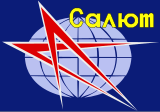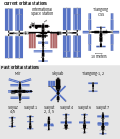cosmos.wikisort.org - SpacecraftDOS-2 designation given to a space station, launched as part of the Salyut programme, which was lost in a launch failure on 29 July 1972, when the failure of the second stage of its Proton-K launch vehicle prevented the station from achieving orbit. It instead fell into the Pacific Ocean. The station, which would have been given the designation Salyut 2 had it reached orbit, was structurally identical to Salyut 1, as it had been assembled as a backup unit for that station.[1] Four teams of cosmonauts were formed to crew the station, of which two would have flown:[1]
Space station
DOS-2 |
|
| Crew | 2 |
|---|
| Launch | 29 July 1972
03:21 UTC |
|---|
| Launch pad | LC-81/24, Baikonur Cosmodrome, USSR |
|---|
| Mass | 18,425 kg
(40,620 lb) |
|---|
| Length | 14 m |
|---|
| Width | 4.15 m |
|---|
| Pressurised volume | c.100 m³ (3,500 ft³) |
|---|
| Days in orbit | 0 days
(Launch failure) |
|---|
| References: [1][2] |
|
 Planned orbital configuration of DOS-2 |
|
|
Whilst Salyut 1 has been attempted to be visited by two three-man crews (Soyuz 10 and Soyuz 11), following modifications to the Soyuz 7KT-OK spacecraft (resulting in the new model Soyuz 7K-T) following the deaths of the crew of Soyuz 11, the spacecraft could only carry two cosmonauts, thus DOS-2 would have been manned by two crews of two. Following the loss of the station, the crews were transferred to the DOS-3 programme.[1]
References
- Grujica S. Ivanovich (2008). Salyut: The First Space Station. Springer-Praxis. ISBN 978-0-387-73585-6.
- David Portree (1995). "Mir Hardware Heritage" (PDF). NASA. Archived from the original (PDF) on 2009-09-07.
 Soviet Union portal
Soviet Union portal Spaceflight portal
Spaceflight portal
Salyut programme |
|---|
| Salyut stations (DOS) | | |
|---|
| Almaz stations (OPS) | |
|---|
| Successors | |
|---|
| TKS spacecraft | |
|---|
| Support craft |
- Soyuz
- Progress
- TKS
- VA
- FGB
|
|---|
| Lists |
- Expeditions
- Spaceflights
- Visitors
- Spacewalks
|
|---|
| Related | |
|---|
Space stations and habitats |
|---|
List of space stations |
| Current | | |
|---|
| Past | Russia /
Soviet Union | |
|---|
| United States | |
|---|
| China | |
|---|
| Private | |
|---|
|
|---|
| Canceled | | Individual projects |
- Deep Space Habitat
- Excalibur Almaz
- Exploration Gateway Platform
- Galaxy
- Manned Orbiting Laboratory
- Skylab B
- Sundancer
- Tiangong-3
|
|---|
| Incorporated into ISS | |
|---|
|
|---|
| In development | | Russia |
- Russian Orbital Service Station
|
|---|
| Private |
- Axiom Station
- Bigelow Commercial Space Station
|
|---|
| International | |
|---|
|
|---|
| Concepts |
- Aurora Station
- Bernal sphere
- Bishop Ring
- Industrial Space Facility
- Lunar Orbital Station
- McKendree cylinder
- Nautilus-X
- O'Neill cylinder
- OPSEK
- Orbital Reef
- Orbital Technologies Commercial Space Station
- Rotating wheel
- Skylab II (FlexCraft)
- Space habitat
- Stanford torus
- Starlab Space Station
- Voyager Station
- Wet workshop
|
|---|
| Related | |
|---|
Notes: † Never inhabited due to launch or on-orbit failure, ‡ Part of the Almaz military program, ° Never inhabited, lacks docking mechanism. |
← 1971 · Orbital launches in 1972 · 1973 → |
|---|
Kosmos 471 | OPS 1737 · OPS 7719 | Intelsat IV F-4 | Kosmos 472 | HEOS-2 | Kosmos 473 | Luna 20 | Kosmos 474 | OPS 1844 | Kosmos 475 | OPS 1570 | Kosmos 476 | Pioneer 10 | Kosmos 477 · Nauka-14KS No.1 | TD-1A | Kosmos 478 | OPS 1678 | Kosmos 479 | OPS 5058 | Kosmos 480 | Kosmos 481 | Venera 8 | Meteor-MV No.23 | Kosmos 482 | Kosmos 483 | Molniya-1 No.27 · SRET-1 | Kosmos 484 · Nauka-5KS No.3 | Interkosmos 6 | Kosmos 485 | Prognoz 1 | Kosmos 486 | Apollo 16 (PFS-2) | OPS 5640 | Kosmos 487 | DS-P1-Yu No. 51 | Kosmos 488 | Kosmos 489 | Kosmos 490 · Nauka-1KS No.5 | Molniya-2-2 | OPS 6574 | Kosmos 491 | OPS 6371 | Kosmos 492 | Intelsat IV F-5 | Kosmos 493 | Kosmos 494 | Kosmos 495 | Kosmos 496 | Prognoz 2 | Interkosmos 7 | Kosmos 497 | Meteor-MV No.26 | Kosmos 498 | Kosmos 499 | OPS 7293 · OPS 7803 | Kosmos 500 | Kosmos 501 | Kosmos 502 | Kosmos 503 | Kosmos 504 · Kosmos 505 · Kosmos 506 · Kosmos 507 · Kosmos 508 · Kosmos 509 · Kosmos 510 · Kosmos 511 | ERTS-1 | Kosmos 512 | DOS No.122 | Kosmos 513 | Explorer 46 | Kosmos 514 | Kosmos 515 | Denpa | Copernicus | Kosmos 516 | Kosmos 517 | OPS 8888 | Unnamed | Triad 1 | Kosmos 518 | Kosmos 519 | Kosmos 520 | Explorer 47 | Kosmos 521 | Molniya-2-3 | Radcat 2 · Radsat | Kosmos 522 | Kosmos 523 | OPS 8314 · OPS 8314/2 | Kosmos 524 | Molniya-1 No.26 | NOAA-2 · OSCAR-6 | Unnamed | Kosmos 525 · Nauka-16KS No.1L | Kosmos 526 | Meteor-M No.25 | Kosmos 527 | Kosmos 528 · Kosmos 529 · Kosmos 530 · Kosmos 531 · Kosmos 532 · Kosmos 533 · Kosmos 534 · Kosmos 535 | Kosmos 536 | OPS 7323 | Anik A1 | Explorer 48 | ESRO-4 | Unnamed | Kosmos 537 | Interkosmos 8 | Molniya-1 No.28 | Apollo 17 | Nimbus 5 | Molniya-2-4 | Kosmos 538 | Aeros 1 | OPS 9390 | Kosmos 539 | OPS 3978 | Kosmos 540 | Kosmos 541 | Kosmos 542 |
Payloads are separated by bullets ( · ), launches by pipes ( | ). Crewed flights are indicated in underline. Uncatalogued launch failures are listed in italics. Payloads deployed from other spacecraft are denoted in (brackets). |
Текст в блоке "Читать" взят с сайта "Википедия" и доступен по лицензии Creative Commons Attribution-ShareAlike; в отдельных случаях могут действовать дополнительные условия.
Другой контент может иметь иную лицензию. Перед использованием материалов сайта WikiSort.org внимательно изучите правила лицензирования конкретных элементов наполнения сайта.
2019-2025
WikiSort.org - проект по пересортировке и дополнению контента Википедии



